ISSN 2348-313X (Print)
International Journal of Life Sciences Research ISSN 2348-3148 (online)
Vol. 9, Issue 4, pp: (79-88), Month: October - December 2021, Available at: www.researchpublish.com

ISSN 2348-313X (Print)
International Journal of Life Sciences Research ISSN 2348-3148 (online)
Vol. 9, Issue 4, pp: (79-88), Month: October - December 2021, Available at: www.researchpublish.com
Suparna Mandal1, K.N. Hemavathi2 , M.D.Venkatesh3, S. Asha Devi 1*
1Laboratory of Gerontology, Department of Zoology, Bangalore University, Bengaluru 560056, Karnataka
2DBT-BIF Facility, Department of Biotechnology, Maharani Lakshmi Ammanni College for Women, Bengaluru 560012. Karnataka
3Department of Animal Sciences, Bengaluru City University, Bengaluru 560001, Karnataka, India E-mail: sambeashadevi@bub.ernet.in, Telephone: 9880303391
Abstract: Bioactive chemicals derived from various parts of the fruit Vitis vinifera (grape fruit) have been proved to possess anti-diabetic, antioxidant, anti-inflammatory, skin-protecting, anti-cancer, and antibacterial properties in recent findings. This study used in silico ADMET analysis for chemical profiling, docking of procyanidin and anthocyanidin compounds identified in grape seed with the receptor aldose reductase (PDB ID: 1US0), and ligand binding capacity analysis. Simulation was used to evaluate five compounds, with the CID 9064 and 65056 showing high binding energy and strong interactions with the AR (PDB ID: 1US0). Together, the current in-silico analysis indicates Vitis as a valuable source of inhibitors of AR inhibitors that can be used in complementary and alternative medicine to prevent and treat diabetic disorder as well. The findings have provided more insight into designing a strategy and probable mechanism of inhibitors found in Vitis against aldose reductase using computer aided drug designing.
Keywords: Cholesterol; Cognition; Hyperlipidemia; Inflammation; Metabolic Disorders; Polyphenols; Proanthocyanidins; Erythrocytes.
Proanthocyanidins (PACs) are polyphenolic compounds that are highly focused in the nutraceutical field for their health benefits. Many evidences on animal and human studies have indicated that the intake of natural polyphenols is closely related to the decrease of “civilization disease” incidences, such as diabetes, and several forms of dyslipidemia [1],[2],[3]. The benefits derived from consumption of PACs are related to their nutritional aspects [4] and phytochemical properties [5]. In vitro, PACS exhibit strong antioxidant activity in scavenging reactive oxygen and nitrogen species, modulating immune function and platelet activation by inducing nitric oxide (NO) release from endothelium [6]. In addition, PACS also inhibits the progression of atherosclerosis and prevent the increase of low-density lipoprotein (LDL) cholesterol concentration [7].
Studies have been conducted extensively on grape seeds to evaluate their bioactive compounds [8],[9]. Grape seed extract (GSE) contain a mixture of monomers (5–30%), oligomers (17–63%), and polymers (11–39%) composed of PACs. The red color and bitterness of GSE can be attributed to PACs. Grape seed proanthocyanidin extract (GSPE), a flavonoid polyphenolic compound, is a rich source monomers, catechin, (-) epicatechin gallate and gallic acid along with polymeric and oligomeric PACs by C4–C6 or C4–C8 bond links (Figure 1).
ISSN 2348-313X (Print)
International Journal of Life Sciences Research ISSN 2348-3148 (online) Vol. 9, Issue 4, pp: (79-88), Month: October - December 2021, Available at: www.researchpublish.com
Being electron donors, they nullify the toxicity of free radicals, and function as effective antioxidants. In addition, GSPE is a much sought-after PAC for their pharmacological outcomes on insulin resistance [10] Anthocyanins are the pigments present in most of the plants, flowers and fruits. Berries like grapes are said to have more amount of anthocyanins [11]. Flowers and fruits are used to produce colouring agents as they give red, blue and purple colour. Fruits, flowers containing anthocyanins are widely consumed for their hepatoprotective, cardioprotective and neuroprotective effects. Supplementation with grape seed PACs reduces post-prandial glucose within 30 min compared with a high-carbohydrate diet alone in healthy humans. GSPE can significantly maintain blood glucose with age while elevating muscle and liver glycogen reserves. Further, progress in ageing research has indicated that GSPE combined with physical exercise attenuates glucose dyshomeostasis. Proanthocyanidins have a prominent role in pathways related to glucose homeostasis in metabolic syndrome in humans as well as in animal models wherein they alleviate high-fat-derived hyperglycaemia. Montagut et al. [10] have demonstrated that Wistar female rats supplemented with 25 mg GSE/kg body weight/ day for 30 days improved homeostasis model assessment-insulin resistance index as a result of downregulation of primers Glut4, Irs1, and Pparg2 in white adipose tissue. Further, their findings suggested the exertion of long-term effects of grape seed procyanidin in establishing glucose homeostasis against diabetes.
Studies indicate that GSPE can alter lipid uptake in rats through the up-regulation of 5' adenosine monophosphateactivated protein kinase and the oxidation of fatty acids [12]. Hence, GSEs have a great impact on consumers because of their potential health benefits [6]. In fact, the blood glucose homeostasis in the body is achieved through the mediation of two hormones, insulin and glucagon, that are antagonistic to each functionally. These hormones arise from the endocrine cells located in the islets of Langerhans of the pancreas [13]. Our lab has been focusing on GSPE and its hypoglycaemic and lipid-lowering effects apart from their local anti-inflammatory actions in the pancreas and brain of Type1 diabetes in male Wistar rat as an experimental model [14],[15]. Further, GSPE is a metal chelator, thus offering protection against inflammation and related metabolic pathologies [16], [17]. In addition, our studies [15] and those of Pinent et al. [18] on streptozotocin- and alloxan-induced T1DM [19] in rats have evidenced the anti-hyperglycaemic effects of GSPE. Interestingly, determining GSPE dosage in animal species is interpreted for humans based on the guidelines from the Food and Drug Administration (FDA) that primarily considers body surface area across species [20].
Since the rise of databases [21] such as PDB (www.rcsb.org), ChEMBL (https://www.ebi.ac.uk/chembl/), PubChem (https://pubchem.ncbi.nlm.nih.gov/), and the Drug Bank [22], as well as new information from traditional in vivo and in vitro studies, computational methods in medicinal chemistry have become more popular.Molecular docking is a technique employed to predict the interaction of protein with ligand molecule[11]. The significance of docking is to select ligands that bind efficiently in their native conformation with a protein. Docking tool is required to predict the active sites accurately [23]. The first enzyme in the polyol pathway, aldose reductase (AR), is broadly distributed in mammalian tissues such as lens retina, Schwann cells of nerves and erythrocytes [24]. The build-up of intracellular sorbitol is also enhanced due to increased aldose reductase activity. Aldose reductase (AR; ALR2; EC 1.1.1.21) catalyzes reduction of glucose to sorbitol in the presence of nicotinamide adenosine dinucleotide phosphate, leading to excess storage of
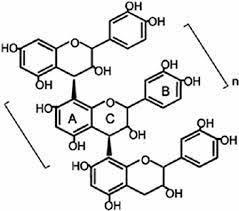
ISSN 2348-313X (Print)
International Journal of Life Sciences Research ISSN 2348-3148 (online) Vol. 9, Issue 4, pp: (79-88), Month: October - December 2021, Available at: www.researchpublish.com
intracellular reactive oxygen species (ROS) in various tissues of DM including the heart and kidneys. It links diabetes mellitus to the development of a variety of secondary problems [25]. The major goal of this work is to use computer-aided drug design methods to evaluate Vitis’ ethnopharmacological knowledge and to build a safe and more dependable diabetes medication.
Ligand molecules like procyanidin trimerC1 (CID:169853), procyanidinB4a (CID: 147299), procyanidineB2a (CID: 122738), procyanidinB3a(CID: 146798), procyanidinB1a (CID: 11250133), were tabulated, screened and the structures were downloaded from pubchem database. in Table 1.
TABLE 1: Compound ID (CID) screened and downloaded from Pubchem database
Compound ID (CID) at Pubchem Iupac Name of the compound
Structure2D_CID_9064 (2R,3S)‐2‐(3,4‐dihydroxyphenyl)‐3,4‐dihydro‐2H‐1‐benzopyran‐3,5,7‐triol
Structure2D_CID_65056 (2S,3S)‐2‐(3,4‐dihydroxyphenyl)‐5,7‐dihydroxy‐3,4‐dihydro‐2H‐1‐benzopyran‐3‐yl 3,4,5‐trihydroxybenzoate
Structure2D_CID_65064 (2R,3R)‐5,7‐dihydroxy‐2‐(3,4,5‐trihydroxyphenyl)‐3,4‐dihydro‐2H‐1‐benzopyran‐3‐yl 3,4,5‐Trihydroxybenzoate
Structure2D_CID_65084 (2R,3S)‐2‐(3,4,5‐trihydroxyphenyl)‐3,4‐dihydro‐2H‐1‐benzopyran‐3,5,7‐triol
Structure2D_CID_72276 (2R,3R)‐2‐(3,4‐dihydroxyphenyl)‐3,4‐dihydro‐2H‐1‐benzopyran‐3,5,7‐triol
Structure2D_CID_72277 (2R,3R)‐2‐(3,4,5‐trihydroxyphenyl)‐3,4‐dihydro‐2H‐1‐benzopyran‐3,5,7‐triol
Structure2D_CID_199472 (2S,3R)‐5,7‐dihydroxy‐2‐(3,4,5‐trihydroxyphenyl)‐3,4‐dihydro‐2H‐1‐benzopyran‐3‐yl 3,4,5‐
Trihydroxybenzoate
The ligand compounds which were unavailable in 3D format were downloaded in 2D format and converted to 3D using chem draw and energy minimization was done. The file obtained was in sdf format, open babel tool was used to convert the file into .pdb format. The goal of energy minimization is to assist the docking algorithm in selecting the bioactive conformer among the local minima. One of the most important benefits of iGemdock is that it aids in the assignment of missing bond ordering, charges, bonds, and hybridization states of imported ligands. Figure 2 depicts the two-dimensional structures of screened ligands.
ISSN 2348-313X (Print)
International Journal of Life Sciences Research ISSN 2348-3148 (online) Vol. 9, Issue 4, pp: (79-88), Month: October - December 2021, Available at: www.researchpublish.com
Figure 2: Proanthocynidines and anthocyanins found in Vitis vinifera
The three-dimensional crystal structure of AR receptor taken from Protein Data Bank (PDB) (http://www.rcsb.org/) AR (PDB ID: 1US0) [Howard et al., 2004] (Figure 3)
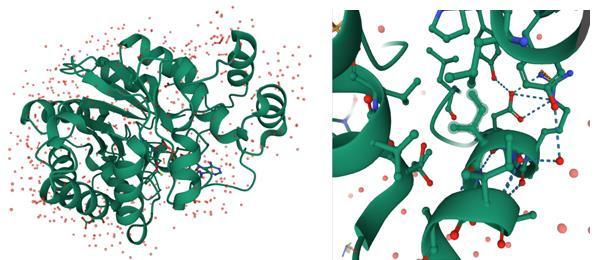
Fig. 3: 3D structure of 1USO protein and active side
Protein quality was checked using Ramachandran plot. The structure was selected based on an analysis of 118 structures of resolution of at least 2.0 Angstroms and R-factor no greater than 20.0 a good quality model would be expected to have over 90% in the most favoured regions [A,B,L].
Usually structure obtained from PDB contains heavy atoms, metal ions and water molecules which have no information about bond orders, atomic charges or topologies and neeed to be cleaned to obtain desired conformation. It might also contain few misaligned groups. Tautomeric and ionization states are also unassigned [26].
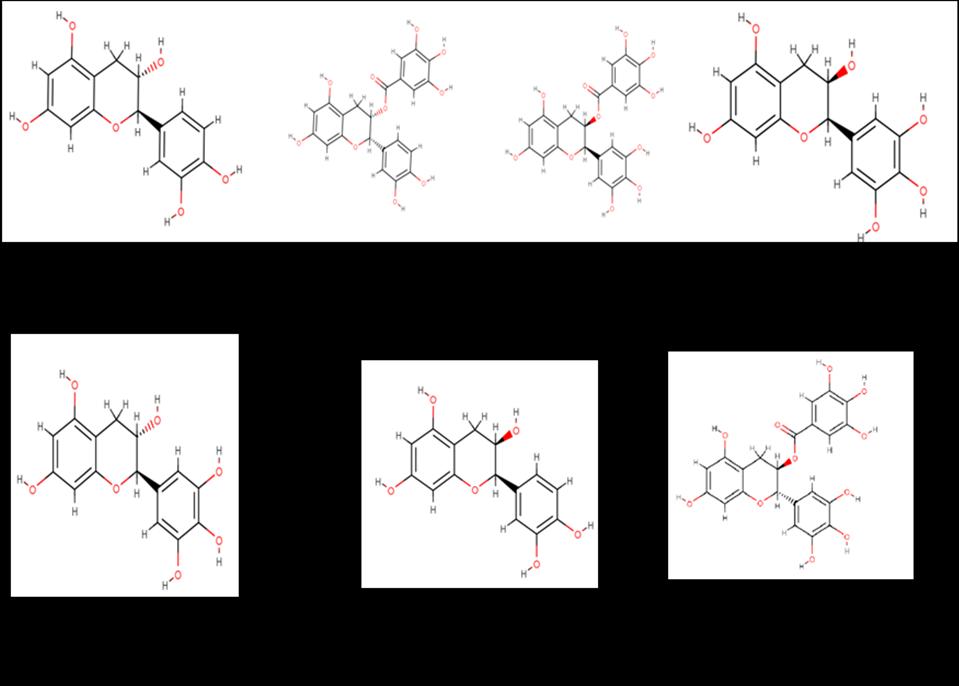
ISSN 2348-313X (Print)
International Journal of Life Sciences Research ISSN 2348-3148 (online) Vol. 9, Issue 4, pp: (79-88), Month: October - December 2021, Available at: www.researchpublish.com

Prediction of binding site –
PrankWeb webserver was used to predict binding site [27]. The ligplot software was used to visulize the active site. The interactions shown are those mediated by hydrogen bonds and by hydrophobic contacts. Hydrogen bonds are indicated by dashed lines between the atoms involved, while hydrophobic contacts are represented by an arc with spokes radiating towards the ligand atoms they contact. The contacted atoms are shown with spokes radiating back.
The iGemdock tool was used to perform the computational docking processes in this study, which is useful for recognising pharmacological interactions and virtual screening. Using iGemdock, the target protein 1USO from the PDB was docked to all of the ligands from Pubchem to determine the best binding site and analyse the protein-ligand interaction patterns. The docking technique took into account all of the chains in the 1USO protein molecule. The protein and ligand molecules were placed in the "prepare binding site" and "prepare compounds" areas, respectively. The "population size" and "generations" were both set to 50. The option "start dock" was chosen to start the docking operation. Rasmol software was used to examine the ligand-protein interactions. The data was analysed, and the ligand with the best dock score function was chosen.
The scoring algorithm has to be evaluated first for the crystal structures to guarantee that ligands docked and provide accurate interaction with receptor (PDB: 1USO). In light of this, IDD594 (2-(4-bromo-2-fluorobenzylthiocarbamoyl)-5(fluoro-phenoxy)-acetic acid was used to evaluate AR (PDB ID: 1USO). As shown in Table 2, they were used as control docking models. The docking result showed that iGemdock found the best orientation for the internal ligands.
iGEMDOCK software was used to dock the receptor protein against all of the screened compounds, revealing drug-like characteristics, and the results were recorded. The goal of the research was to come up with appropriate binding geometries and investigate protein-ligand interactions. Using already bound ligand, the selected cavity in the iGEMDOCK aids in determining the active site or pre-existing active site for the receptor. The ligands inside the receptor are separated by a calculated physical distance (8 in this method), and the lead is released after a series of conformational modifications. The chemical makes its way into the receptor's active site. The motions include translations, rotations, and internal modifications to the ligand's structure, including torsion angle rotations. The system incurs a total energetic cost in Gibbs free energy for each of these conformational changes in the ligand. As a result, after each move, binding energy = A+B+C-D is estimated and computed, where A denotes final intermolecular energy + Vanderwalls energy (vdW) + hydrogen bonds + desolvation energy + electrostatic energy (kcal/mol), B denotes final total internal energy (kcal/mol), C denotes torsional free energy (kcal/mol), and D denotes unbound system's energy (kcal/mol) [26]
ISSN 2348-313X (Print)
International Journal of Life Sciences Research ISSN 2348-3148 (online) Vol. 9, Issue 4, pp: (79-88), Month: October - December 2021, Available at: www.researchpublish.com
Only a few compounds were able to pass the Lipinski criteria of five out of the 15 that were docked. Apart from docking energy, the binding mechanisms and interactions of each ligand with the functional residues of AR were examined in detail by visually analysing the docked complexes using iGemdock. In docking results, the hydrogen bonds involved with bond length were also taken into account. Table 2 show the docking results of our compounds against each PDB structure. When the value of logP is compared to docking score on different PDBs, it is concluded that logP and docking score have no relationship. The docking score of each molecule employed in the study can be compared to the H-bond acceptor. Molecules with an intermediate H-bond acceptor value and an intermediate logP value may be considered good antidiabetic components.
PrankWeb is an internet resource that provides access to P2Rank, a cutting-edge approach for predicting ligand binding sites. P2Rank is a template-free machine learning method based on local chemical neighbourhood ligand ability prediction centred on locations on a solvent-accessible protein surface [27]. The ligand binding sites are formed by clustering points with a high ligandability score. Active site found to be at A-chain having THR19, TRP20, LYS21, ASP43, SER159, ASN160, SER210, LEU212, SER214, LYS262, THR265, AR268, GLU271, ASN272 (Figure 5).
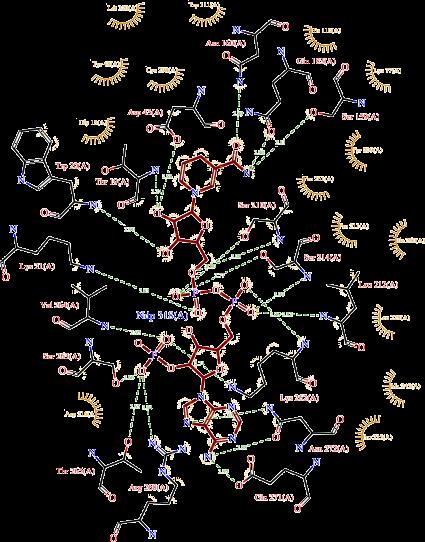
Wallace A and Laskowski R. LIGPLOT v.4.5.3
[28]
The bond strains are accounted for by the first term in the energy function, where b=bond force constant and bbo=distance from equilibrium that the atom has moved. The bond angles are represented by the second term in, where is the angle force constant and -o is the angle from equilibrium between three linked atoms. The third term is for the torsion angles where κϕ = dihedral force constant, n = multiplicity of the function, ϕ= dihedral angle and δ = phase shift. The fourth term accounts for out of plane bending, where Kω = force constant and ω-ωo= out of plane angle. The fifth term is
ISSN 2348-313X (Print)
International Journal of Life Sciences Research ISSN 2348-3148 (online) Vol. 9, Issue 4, pp: (79-88), Month: October - December 2021, Available at: www.researchpublish.com
the Urey-Bradley component, where U is the relevant force constant and U is the distance between the 1,3 atoms in the harmonic potential. The last two terms reflect non-bonded interactions between pairs of atoms I j). Non-bonded forces are only applied to atom pairs separated by at least three bonds by definition.
The electrostatic energy is computed using a Coulombic potential and the van Der Waals (VDW) energy is determined using a standard Lennard-Jones potential. The Rmini j term in the Lennard-Jones potential above is not the minimum of the potential, but rather the point at which the Lennard-Jones potential crosses the x-axis.
According to the results of docking score values on AR for anti-diabetic activity, constituents such as 9064, 65056, 72276 and 72276 had the best docking results, with the most significant effects observed on PDB ID: 1US0 against internal standard IDD594 (Table 2).
Table 2: iGemDock score of internal ligand and extracted internal ligand of docked receptor-ligand complex structures
Compound Energy
cav1us0_NDP-4369325-0.pdb -149.12 cav1us0_NDP-65056-0.pdb -144.072 cav1us0_NDP-9064-1.pdb -131.005 cav1us0_NDP-72276-1.pdb -133.706 cav1us0_NDP-72277-1.pdb -126.565 cav1us0_NDP-65064-0.pdb -120.233
Theses energies were released because of VDW, H bonds interaction between ligands and receptor. The bonding energy release can be found in Table 3
Table 3- Energy release in making of docking complex

Compound VDW HBond Int.ClusterID
cav1us0_NDP-65056-0.pdb -127.532 -16.5398 38.1563
cav1us0_NDP-9064-1.pdb -115.19 -15.8149 39.381 cav1us0_NDP-72276-1.pdb -122.475 -11.2312 39.2857 cav1us0_NDP-72277-1.pdb -110.291 -16.2739 36.9545 cav1us0_NDP-65064-0.pdb -84.2207 -36.0119 39.6364
ISSN 2348-313X (Print)
International Journal of Life Sciences Research ISSN 2348-3148 (online)
Vol. 9, Issue 4, pp: (79-88), Month: October - December 2021, Available at: www.researchpublish.com
Figure 5 shows the interaction of the standard and 9064. The traditional medicinal system has numerous options, which have yet to be fully explored for the treatment of many diseases [29]; nevertheless, if current computational chemistry tools are used to fully explore the potential of the old medicinal system, amazing results can be obtained[30], [31]. Many scientists have conducted similar investigations in the past, in which bioactive chemicals are docked on a certain receptor to determine its affinity [29], [32], [33], [34],
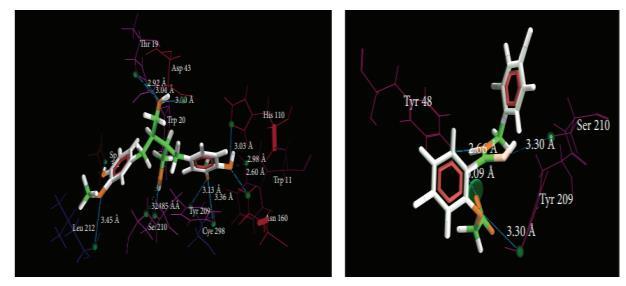
For assessing the possible antidiabetic components and their mechanism of action, authors applied structure-based drug design. The primary goal of choosing the AR receptor was to identify the main pathway via which Vitis vinifera may manifests its antidiabetic properties. The active ingredients from Vitis were shown to be highly active on aldose reductase, according to docking data. Many studies have confirmed the role of aldose reductase inhibitors in diabetes [35], [36] Furthermore, we discovered that 9064 has the highest affinity for the enzyme aldose reductase (Figure 6a) as compared with 65056 In our molecular docking simulation on 1US0, it was found that Tyr 48 is the main amino acid is interacting with the 9064.
To conclude, the current research work was an attempt to draw insight into the structural, functional, and dynamical aspects of phytocompounds from Vitis vinifera. In the process, the compounds from literature revealed the presence of 15 anthocyanins and proanthocyanidins. These can be used to hypothesize a novel drug against diabetes as Vitis seeds is reported to have anticancer and antidiabetic properties. Our claims may be further strengthened and proved through attempts on in vitro and in vivo studies using a natural product, grape seed proanthocyanidin because of their efficient reduction of aldolase in the erythrocyte and inhibiting the occurrence of various related complications.
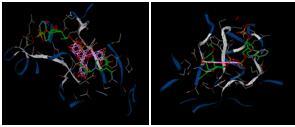
The authors have no conflicts of interest to disclose.
The authors acknowledge Dr. Sushil Kumar Middha, Coordinator, DBT-BIF computational facility and BiSEP facility at MLACW was used to carry out the research work We acknowledge the award of research fellowship by the UGC-CSIR to Ms.Suparna Mandal.
[1] Mannino G, Iovino P, Lauria A, et al (2021) Bioactive Triterpenes of Protium heptaphyllum Gum resin extract display cholesterol-lowering potential Int J Mol Sci 22: 2664
[2] Carson JAS, Lichtenstein AH, Anderson CAM et al (2020). Dietary cholesterol and cardiovascular risk: A science advisory from the American heart association. Circulation 141: e39–e53
[3] Middha SK, Usha T, Basistha BC. et al (2019) Amelioration of antioxidant potential, toxicity, and antihyperglycemic activity of Hippophae salicifolia D. Don leaf extracts in alloxan-induced diabetic rats. Biotech 9: 308.
[4] González S (2020). Dietary bioactive compounds and human health and disease. Nutrients 12: 348
ISSN 2348-313X (Print) International Journal of Life Sciences Research ISSN 2348-3148 (online) Vol. 9, Issue 4, pp: (79-88), Month: October - December 2021, Available at: www.researchpublish.com
[5] Quideau S, Deffieux D, Douat-Casassus C et al (2011) Plant polyphenols: Chemical properties, biological activities, and synthesis. Angew Chem Int Ed Engl 50: 586–621.
[6] Varzakas T, Zakynthinos G, Verpoort F (2016) Plant food residues as a source of nutraceuticals and functional foods Foods 5:88
[7] Quesada H, del Bas JM, Pajuelo D et al (2009) Grape seed proanthocyanidins correct dyslipidemia associated with a high-fat diet in rats and repress genes controlling lipogenesis and VLDL assembling in liver. Int J Obesity 33: 1007–1012.
[8] Rodríguez Montealegre R, Romero Peces R, Chacón Vozmediano JL et al (2006) Phenolic compounds in skins and seeds of ten grape Vitis vinifera varieties grown in a warm climate. J Food Compost Anal 19: 687–693.
[9] Pastrana-Bonilla E, Akoh CC, Sellappan S et al (2003) Phenolic content and antioxidant capacity of muscadine grapes. J Agric Food Chem 51: 5497–5503.
[10] Montagut G, Bladé C, Blay M et al (2010) Effects of a grape seed procyanidin extract (GSPE) on insulin resistance. J Nutri Biochem 21: 961–967.
[11] Khoo HE, Azlan A, Tang ST et al (2017) Anthocyanidins and anthocyanins: colored pigments as food, pharmaceutical ingredients, and the potential health benefits. J Food Nutr Res 61: 1361779.
[12] Crescenti A, del Bas JM, Arola-Arnal A et al (2015) Grape seed procyanidins administered at physiological doses to rats during pregnancy and lactation promote lipid oxidation and upregulate AMPK in the muscle of male offspring in adulthood. J Nutri Biochem 26: 912–920.
[13] Campbell JE and Drucker DJ (2015) Islet α cells and glucagon-critical regulators of energy homeostasis. Nat Rev Endocrinol 11: 329-338.
[14] Rajasekhar S, Muthangi VV Subramanyam, Asha Devi S (2021) Grape seed proanthocyanidin extract suppresses oxidative stress in the rat pancreas of type-1diabetes. Arch Physiol Biochem 3:1-13.
[15] Rajasekhar S, Subramanyam M, Chandrasekhar Sagar BK et al (2019) Grape seed proanthocyanidin extract and insulin prevents cognitive decline in type 1 diabetic rat by impacting Bcl-2 and Bax in the prefrontal cortex. Metab Brain Dis 34: 103–117.
[16] Lian Q, Nie Y, Zhang X (2016) Effects of grape seed proanthocyanidin on Alzheimer's disease in vitro and in vivo. Exp Ther Med 12:1681-1692.
[17] Gonzalez-Albuin N, Pinent M, Casinova-Marti A et al (2015) Procyanidins and their healthy protective effects against type 2 diabetes. Curr Med Chem 22: 39-50.
[18] Pinent M, Blay M, Bladé MC et al (2004). Grape seed-derived procyanidins have an antihyperglycemic effect in streptozotocin-induced diabetic rats and insulinomimetic activity in insulin-sensitive cell lines. Endocrinology 145: 4985-4990.
[19] El-Alf, AT, Ahmed AA, Fatani, AJ (2005) Protective effect of red grape seeds proanthocyanidins against induction of diabetes by alloxan in rats. Pharmacol Res 52: 264-270.
[20] Redlarski G Palkowski A, Krawczuk M (2016). Body surface area formulae: an alarming ambiguity. Sci Reports 6: 27966.
[21] Usha T, Middha SK, Kukanur AA et al (2021) Drug repurposing approaches: Existing leads for novel threats and drug targets. Curr Prot Peptide Sci 22: 251 – 271
[22] Wishart DS, Knox C, Guo AC et al (2006) Drug Bank: a comprehensive resource for in silico drug discovery and exploration. Nucleic Acids Res 34: D668–D672
[23] Muthu S and Durairaj B (2016) Molecular docking studies on interaction of Annonamuricata compounds with antiapoptotic proteins Bcl-2 and survivin. Sky J Biochem Res 5: 014-017
ISSN 2348-313X (Print) International Journal of Life Sciences Research ISSN 2348-3148 (online) Vol. 9, Issue 4, pp: (79-88), Month: October - December 2021, Available at: www.researchpublish.com
[24] Das B and Srivastava SK (1985) Purification and properties of aldose reductase and aldehyde reductase II from human erythrocyte. Arch Biochem Biophy. 238: 670–679.
[25] Muthenna P, Suryanarayana P, Gunda SK et al (2009) Inhibition of aldose reductase by dietary antioxidant curcumin: mechanism of inhibition, specificity and significance FEBS Lett, 583: 3637–3642
[26] Middha SK, Goyal AK, Faizan SA et al (2013) In silico–based combinatorial pharmacophore modelling and docking studies of GSK-3β and GK inhibitors of Hippophae J Biosci 38: 805–814
[27] Jendele L, Krivak R, Skoda P, et al. (2019) PrankWeb: a web server for ligand binding site prediction and visualization. Nucleic Acids Res 47(W1): W345–W349.
[28] Wallace A and Laskowski R.LIGPLOT v.4.5.3 - Program for automatically plotting protein-ligand interactions https://www.ebi.ac.uk/thornton-srv/software/LIGPLOT/ (accessed on 27-11-2021)
[29] Usha T, Middha SK, Shanmugarajan D et al (2021) Gas chromatography-mass spectrometry metabolic profiling, molecular simulation and dynamics of diverse phytochemicals of Punica granatum L. leaves against estrogen receptor. Front. Biosci. –Landmark 9: 423-441.
[30] Usha T, Shanmugarajan D, Goyal Ak, et al (2017) Recent updates on computer-aided drug discovery:time for a paradigm shift. Curr Topics in Med Chem 17: 3296–3307
[31] Middha SK, Usha T, Basistha BC. et al (2019) Amelioration of antioxidant potential, toxicity, and antihyperglycemic activity of Hippophae salicifolia D. Don leaf extracts in alloxan-induced diabetic rats. 3 Biotech 9: 308.
[32] Usha T, Middha SK, Kukanur AA et al (2020) Drug repurposing approaches: Existing leads for novel threats and drug targets. Curr Protein Pep. Sci 22: 251-271
[33] Usha T, Goyal AK, Lubna S et al. (2014) Identification of anti-cancer targets of eco-friendly waste Punica granatum peel by dual reverse virtual screening and binding analysis. Asian Pac J Cancer Prev 15:10345–10350.
[34] Trinh Q and Le L (2014) An investigation of antidiabetic activities of bioactive compounds in hirta Linn molecular docking and pharmacophore Med Chem Res 23: 2033–2045
[35] Jannapureddy S, Sharma M, Yepuri G et al (2021)Aldose Reductase: An Emerging Target for Development of interventions for diabetic cardiovascular complications. Front Endocrinol 12:636267.
[36] Hu X, Li S, Yang G et al (2014) Efficacy and safety of aldose reductase inhibitor for the treatment of diabetic cardiovascular autonomic neuropathy: Systematic review and meta-analysis. PLoS ONE 9: e87096.